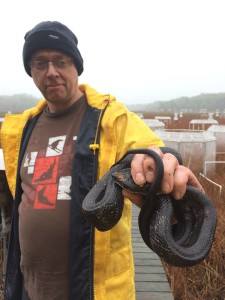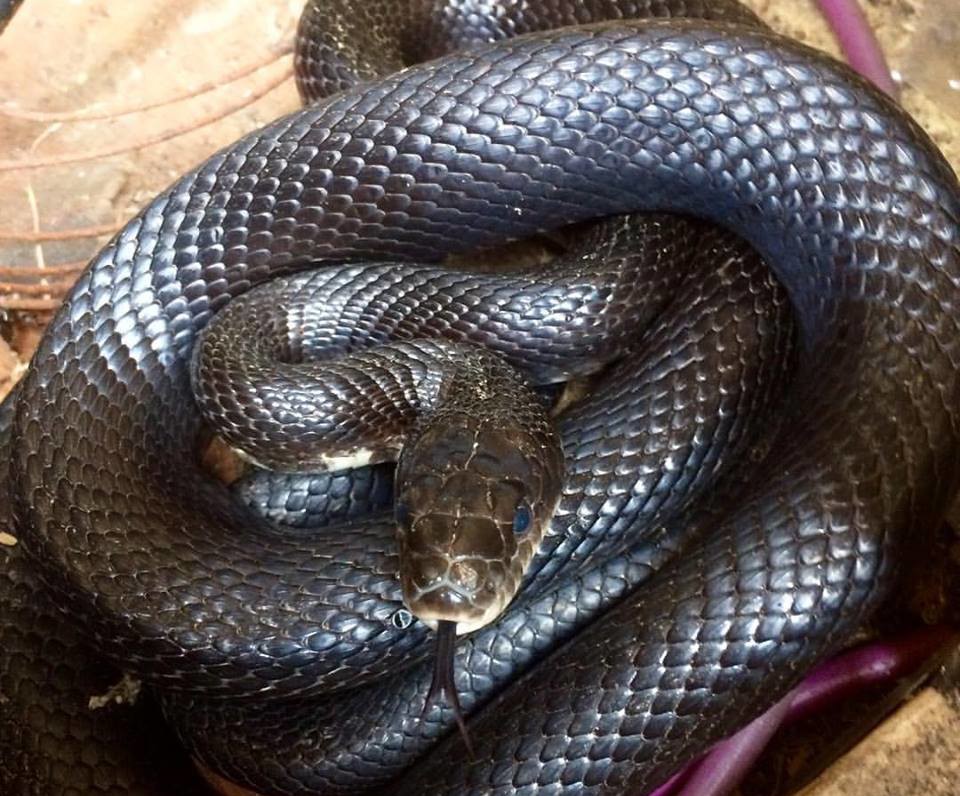by Sara Richmond

Scientist Guy Thompson holds up an eastern rat snake found at GCREW. (Credit: Gary Peresta/SERC)
To some, snakes are difficult creatures to love. Despite their reputation, however, snakes play critical roles in their environments by keeping populations of their prey in check. That’s why many scientists at the Smithsonian Environmental Research Center (SERC) have grown to appreciate their presence, particularly the eastern rat snake.
Eastern rat snakes, also known as black rat snakes or Pantherophis alleghaniensis to herpetologists, are a common sighting near SERC’s Global Change Research Wetland (GCREW). The GCREW project sits in roughly 170 acres of brackish marsh and is home to several experiments investigating rising sea levels, invasive species, global temperatures, carbon dioxide and other major players in global change.

Environmental engineer Gary Peresta has found several snakes camping out around SERC’s marsh experiments over the years. (Credit: SERC)
“Eastern rat snakes have been very common down at GCREW since our team has been here,” says Gary Peresta, an environmental engineer with the GCREW program. Most years, he starts spotting the snakes in the spring as they come out of brumation—a process similar to hibernation, when the snake can engage in occasional activity such as drinking water. “Usually you see one, but there were three or four together this year, shedding at the same time,” he reports. Peresta and the GCREW team have found the snakes outdoors in the marsh, perched on their experiments, and inside their sheds. “The sheds we use for equipment are nice warm, quiet, dry places for them, but they’re in the way when I have to work in there,” he says. When one of SERC’s former postdoctoral researchers—who also happened to have a herpetology degree—returned for a visit this spring, Peresta consulted him about how to safely handle the snakes and move them when necessary.
Having to move an occasional snake is a minor inconvenience compared to the benefit they provide. True to their name, eastern rat snakes eat rats and other rodents. These rodents can chew through wires on GCREW experiments, hindering researchers’ work. When the snakes are out and about, however, they keep the marsh’s rodent population under control. Eastern rat snakes often do the same in residential areas, preventing unwanted mice and other pests from entering homes.
Eastern rat snakes typically try to avoid humans, but if you do find one, handling it is not advised. Although these snakes are generally not aggressive, they can bite. Additionally, Peresta warns of an unexpected danger when provoking them: They can release a foul-smelling odor, and if it gets on you, it does not wash off easily.
But while an eastern rat snake’s bite may be painful, it’s not venomous. Of the 27 species of snakes native to Maryland, where SERC is located, only two are venomous—the copperhead and timber rattlesnake. Neither species has been sighted at SERC.

An eastern rat snake coils up above the wires at GCREW. (Credit: Gary Peresta/SERC)
According to the Maryland Department of Natural Resources, the eastern rat snake is one of the most common snakes in the state, appearing on farmland, in hardwood forests, forested wetlands, lots and backyards. They make their homes across the eastern United States from southern New England to Florida’s panhandle and in parts of Canada. Adults are recognizable by their plain black backs, irregular black-and-white checkerboard patterns on their bellies, and white chins and throats. Young eastern rat snakes have a mix of gray and brown markings on their backs.
Eastern rat snakes are also relatively large. On average, adults range from 3 and a half to 6 feet in length. The largest ever recorded was a whopping 8 feet, 5 inches (don’t worry, SERC visitors—that one was found in Virginia).
SERC research technician Tyler Bell also encounters the snakes frequently. “They show up in March and April like clockwork,” he says, although he notes that unseasonably warm temperatures may have coaxed them out as early as February this year. Bell’s research requires him to take water samples at SERC’s weirs—V-shaped structures in streams that send water samples to nearby buildings. Sometimes, Bell finds the snakes inside the weir buildings in the spring after emerging from brumation, when there is still a chill in the air. “They curl up on my sampler’s power supply,” he says. “Since it’s always on, it exudes heat. They coil up around the plugs, or just on top of them.”
In the summer, the heat from the sampler is too much for the snakes, but Bell sometimes still finds their skins in the weir buildings’ rafters. He’s spotted them draped across an old brick building as they try to stay cool in the summer, and in other sheds around campus.
“They eat the rodents, so we don’t mind them being here,” says Bell. “Well, some people do, but I’m kind of fond of them.”

